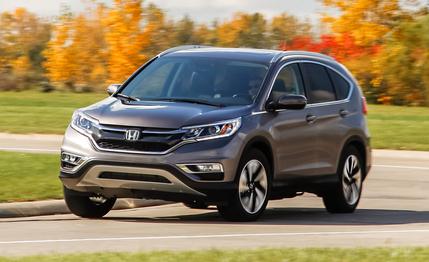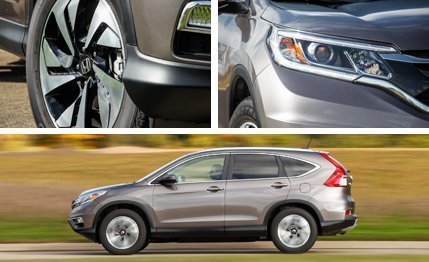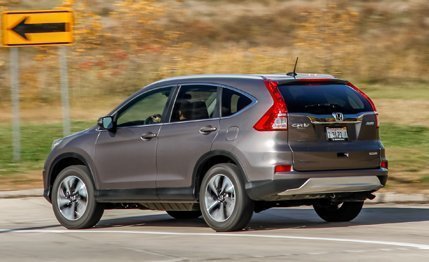
 Instrumented Test
Instrumented Test
It’s as if you went in for an eyelid lift and a chin tuck and emerged with a heart transplant. The refreshed Honda CR-V might wear the same basic sheetmetal as it has since 2012, but the ute’s mechanical and interior changes are significant.
Our tested example, in top-rung Touring trim with four-wheel drive, did have flashy new eyes (projector headlights and LED daytime running lamps). Inside, upgraded, richer-looking materials surround new features like the seven-inch touch- and swipe-sensitive screen found in Honda’s latest sedans.


The new heart is the “Earth Dreams” engine and CVT transplanted from the Accord. This direct-injected 2.4-liter i-VTEC four generates 11 percent more torque at 500 fewer revs (181 pound-feet at 3900 rpm), and its 185-hp peak (same as before) comes at 6400 rpm rather than 7000. The extra grunt is welcome, but Honda’s aim was fuel economy. The EPA ratings jump by 4 mpg city and 3 highway, to 26 and 33. We got 25 mpg versus the 24 we saw in a 2012 model.
As in the Accord, the CVT operates behind a conventional torque converter, and Honda’s shift logic does the best job, so far, of making a CVT painless. Still, with the pedal mashed to the floor, it holds the engine note at one annoying pitch while the trans subtly changes ratios.

 Bottom left: Hondas Lane Keeping Assist System is a real boon for drivers who like to touch the steering wheel only once every 15 seconds.
Bottom left: Hondas Lane Keeping Assist System is a real boon for drivers who like to touch the steering wheel only once every 15 seconds.
At 8.2 seconds, this CR-V is 0.4 quicker to 60 mph than before. And wider tires help it brake to a stop from 70 mph in 171 feet, eight fewer than its predecessor.
Touring trim brings heaps of standard kit, so we were surprised to find the curb weight up only 12 pounds. The loaded Touring has a power liftgate; keyless entry; adaptive cruise control; and the “Honda Sensing” suite of safety nannies, such as forward-collision warning, collision-mitigation braking, and even a Lane Keeping Assist System (LKAS). The latter nanny employs a camera to watch the road and uses the electric steering to actively “help” the driver stay centered for as many as 15 seconds at up to 90 mph.


While sipping coffee at 80 mph, we engaged LKAS with the steering-wheel button and let the car steer. It works well, though eventually the road curves too sharply or you haven’t contributed for too long, so a dim warning lamp blinks to tell you to get your hands on the wheel. We’d prefer a sterner warning, perhaps a klaxon or a voice screaming “We’re all gonna die!” as mom did when dad steered our Rambler wagon with his knee while lighting a smoke. Unlike mom, these electro-nags can be turned off. Honda Sensing comes on the Touring model, which lists at $33,600 with four-wheel drive, fully equipped.
With our hands on the wheel, we found the chassis works better. A quicker steering ratio and suspension changes sharpen the CR-V’s reflexes. Nimbler, it still doesn’t rise to the dynamic standard set by the Mazda CX-5, but this refresh will probably keep the CR-V in its familiar place atop the segment sales chart.